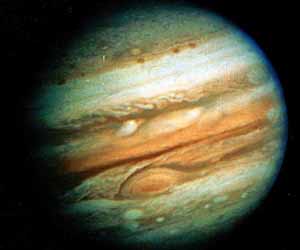Planet Jupiter Facts

Image taken by NASA's Voyager 1 spacecraft on its approach to Jupiter in 1979
- Jupiter is the fifth planet from the sun. Its average distance from the sun is around 484 million miles (779 million km), more than five times Earth's distance.
- The gas giant is the largest planet in the solar system with a diameter of around 89,000 miles (143,000 km).
- Jupiter is 11 times larger than Earth in diameter and around 10% as large as the sun.
- Over 1,000 Earth's could fit inside the volume of Jupiter.
- Below the thick atmosphere of Jupiter there is thought to be a large ocean of metallic hydrogen possibly surrounding a small rocky core.
- The prominent atmospheric feature known as the Great Red Spot is a massive storm which has raged for centuries.
- In 1973 Pioneer 10 became the first spacecraft to visit the planet.
- In July 1994 NASA's Galileo spacecraft captured images of the comet Shoemaker-Levy 9 smashing into Jupiter's upper atmosphere.
- Jupiter is one of the brightest objects in the night sky and can be easily viewed with the naked eye.

You could fit three Earths inside Jupiter's famous Great Red Spot
Jupiter's Atmosphere
The atmosphere of Jupiter is composed of around 90 percent hydrogen with the remaining 10 percent mostly made up of helium.
The surface of the planet we see is cloud cover which
swirls around the top of the atmosphere powered by strong winds generated deep within Jupiter.
The clouds themselves are composed of ammonia crystals which travel around the planet in bands moving at different speeds and in opposite directions,
vortices and spots such as the Great Red Spot pictured left are also prominent features
creating the iconic image of Jupiter that we know today.
Jupiter's Orbit
Jupiter travels once around the Sun every 12 years and spins on its own axis every 10 hours compared to 24 on Earth, making it the fastest rotating planet in the Solar System.
Jupiter's Temperature
The temperature in Jupiter's upper atmosphere is around -145C (-230F). Deeper below the clouds the temperate reaches 21C (70F). Near the planet's center the temperature is around six times hotter than the surface of the Sun!
Moons
Jupiter has 79 moons, most are very small, only 16 of them have a diameter of at least 6 miles (10km). The four main moons of Jupiter are Io, Europa, Ganymede and Callisto,
all discovered in 1610 by Galileo and referred to as the "Galilean Moons".
Origin of Name
Jupiter was named by the Romans after their King of Gods.
Life on Jupiter
Amazing as it may seem some scientists have speculated that life on Jupiter is possible. This would occur beneath the cloud cover where room temperature conditions exist, these lifeforms
would be airborne although this theory is thought to be highly speculative.
Jupiter's Magnetic Field

Aurora at Jupiter's poles are caused by its powerful magnetic field

The volcanic moon Io orbiting Jupiter
Planet Jupiter Statistics
Diameter: 89,000 miles (143,000 km)Average Distance from Sun: 484 million miles (779 million km)
Orbital Period: 12 years
Rotation Period: 9.93 hours
Moons: 63
Maximum Temperatures: 24,000C (43,000F) (Core)
Minimum Temperatures: -145C (-230F) (Cloud Tops)
Gravity: 20.87 m/s2 (2.14 x Earth's Gravity)
Density: 1.33 g/cm3 (24% Earth's Density)
Mass: 1.8987 x 1027 kg (318 x Earth's Mass)
Volume: 1.4255 x 1015 km3 (1316 x Earth's Volume)
Atmosphere: 90% Hydrogen, 9.5% Helium, 0.3% Methane, 0.026% Ammonia, 0.003% Hydrogen deuteride, 0.0006% Ethane, 0.0004% water.